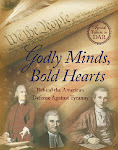In 1865, a group of influential men in France met at the home of Edouard Rene de Laboulaye, a learned man who had great love for the ideas behind America. He believed in the common love for liberty that existed between our country and his.
As Sculptor Bartholdi believed deeply in republican government and dreamed of having it in his native France, he remarked, "I will try to glorify the Republic and Liberty over there, in the hope that someday I will find it again here."
After Bartholdi visited America, he wrote:
Bartholdi's intent was for people around the world to be inspired enough to copy the freedom of America, not to leave their country for ours.
The statue, inaugurated in 1886, was given as a revolutionary symbol for the oppressed to throw off their chains and create their own democracy under law.
The New Colossus
The famous poem, a hymn to immigration, by Emma Lazarus has no connection at all with Bartholdi's vision. Her poem was written "for the occasion" of an auction to raise money for the Statue of Liberty's pedestal. It wasn't until 1903 that friends of the great poet wished to honor her after her death with a dedication.
The New Colossus
Not like the brazen giant of Greek fame,
With conquering limbs astride from land to land;
Here at our sea-washed, sunset gates shall stand
A mighty woman with a torch, whose flame
Is the imprisoned lightning, and her name
Mother of Exiles. From her beacon-hand
Glows world-wide welcome; her mild eyes command
The air-bridged harbor that twin cities frame.
"Keep ancient lands, your storied pomp!" cries she
With silent lips. "Give me your tired, your poor,
Your huddled masses yearning to breathe free,
The wretched refuse of your teeming shore.
Send these, the homeless, tempest-tossed to me,
I lift my lamp beside the golden door!"
The true and noble meaning behind the Statue as "Liberty Enlightening the World" has been lost as the new purpose for America's existence is based on a myth. It is now considered by many to be the world's permanent doormat for which the Statue is the greeter and 'Mother of Exiles.'
James Russell Lowell wrote that the poem gave the Statue of Liberty a "raison d'être," while Paul Auster wrote that "Bartholdi's gigantic effigy was originally intended as a monument to the principles of international republicanism, but 'The New Colossus' reinvented the statue's purpose, turning Liberty into a welcoming mother, a symbol of hope to the outcasts and downtrodden of the world."
Author John T. Cunningham wrote that "The Statue of Liberty was not conceived and sculpted as a symbol of immigration, but it quickly became so as immigrant ships passed under the statue. However, it was Lazarus's poem that permanently stamped on Miss Liberty the role of unofficial greeter of incoming immigrants."
EDOUARD RENE DE LABOULAYE 1811-1883 As proof of the friendship and the community of emotions of the people of the two countries, Laboulaye pointed out that the people of the United States honored the remembrances of common glories, and loved Lafayette and his volunteers as they revered American heroes. He declared that this common heritage was of far greater importance in America than the political acts of the French government. Adapted from Harper's Weekly, December 15, 1866.
"Although a subject of Napoleon III, this outspoken republican had in 1850 printed a discourse on the American Constitution and "the utility of studying it," had written a learned "Political History of the United States," a paper on the youth of Benjamin Franklin, and a novel, "Paris in America," in which a character says: "The folly of love and the madness of ambition are sometimes curable, but no one was ever cured of a mania for liberty." In the same book, liberty is described as the "daughter of the Gospel -- sister of justice and pity -- mother of equality, abundance, and peace."" from STATUE OF LIBERTY ENLIGHTENING THE WORLD By Rodman Gilder, 1943
The French were so moved by the beauty of America's freedom from tyranny, they decided to give a gift to its citizens as a symbol of eternal friendship, a gift that would be from a people to a people, not from a government to a government. Victor Hugo was among those enthusiastic to give a sculpture by Auguste Bartholdi to the robust, fledgling country.
As Sculptor Bartholdi believed deeply in republican government and dreamed of having it in his native France, he remarked, "I will try to glorify the Republic and Liberty over there, in the hope that someday I will find it again here."
After Bartholdi visited America, he wrote:
"The picture that is presented to the view when one arrives at New York is marvelous: when - after some days of voyaging - in the pearly radiance of a beautiful morning is revealed the magnificent spectacle of those immense cities, of those rivers extending as far as the eye can reach, festooned with masts and flags; when one awakes, so to speak, in the midst of that interior sea covered with vessels - some giants in size, some dwarfs - which swarm about puffing, whistling, swinging the great arms of their uncovered walking beams, moving to and fro like a crowd upon a public square, it is thrilling."The hope of France in helping America during the Revolution is remembered and expressed in Bartholdi's statue. Deep inside the artwork is the spirit of Lafayette as he stepped ashore from a small boat, 'offering heart and sword to General Washington.'
Bartholdi's intent was for people around the world to be inspired enough to copy the freedom of America, not to leave their country for ours.
The statue, inaugurated in 1886, was given as a revolutionary symbol for the oppressed to throw off their chains and create their own democracy under law.
The New Colossus
The famous poem, a hymn to immigration, by Emma Lazarus has no connection at all with Bartholdi's vision. Her poem was written "for the occasion" of an auction to raise money for the Statue of Liberty's pedestal. It wasn't until 1903 that friends of the great poet wished to honor her after her death with a dedication.
The New Colossus
Not like the brazen giant of Greek fame,
With conquering limbs astride from land to land;
Here at our sea-washed, sunset gates shall stand
A mighty woman with a torch, whose flame
Is the imprisoned lightning, and her name
Mother of Exiles. From her beacon-hand
Glows world-wide welcome; her mild eyes command
The air-bridged harbor that twin cities frame.
"Keep ancient lands, your storied pomp!" cries she
With silent lips. "Give me your tired, your poor,
Your huddled masses yearning to breathe free,
The wretched refuse of your teeming shore.
Send these, the homeless, tempest-tossed to me,
I lift my lamp beside the golden door!"
The true and noble meaning behind the Statue as "Liberty Enlightening the World" has been lost as the new purpose for America's existence is based on a myth. It is now considered by many to be the world's permanent doormat for which the Statue is the greeter and 'Mother of Exiles.'
James Russell Lowell wrote that the poem gave the Statue of Liberty a "raison d'être," while Paul Auster wrote that "Bartholdi's gigantic effigy was originally intended as a monument to the principles of international republicanism, but 'The New Colossus' reinvented the statue's purpose, turning Liberty into a welcoming mother, a symbol of hope to the outcasts and downtrodden of the world."
Author John T. Cunningham wrote that "The Statue of Liberty was not conceived and sculpted as a symbol of immigration, but it quickly became so as immigrant ships passed under the statue. However, it was Lazarus's poem that permanently stamped on Miss Liberty the role of unofficial greeter of incoming immigrants."
A burqa for the Statue of Liberty?






















































































2 comments:
Post a Comment